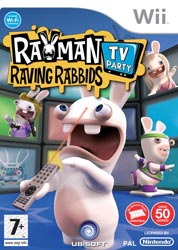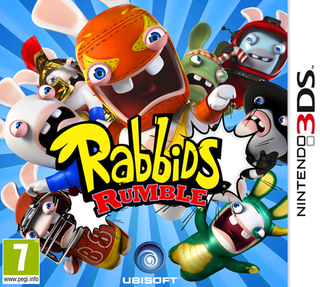
Rayman Raving Rabbids is a 2006 party video game developed and published by Ubisoft. It's a spinoff for the Rayman series and the debut title for the Rabbids franchise. The story follows Rayman as he was interrupted by earthquake in which then he was being kidnapped and forced to played minigames with the Rabbids. The game received generally positive reviews from critics, with some criticizing the minigames either being broken or unenjoyable.
Rayman is a franchise of platform video games, created by video game designer Michel Ancel for Ubisoft. Since the release of the original Rayman game in 1995, the series has produced a total of 45 games across multiple platforms.

Rabbids, also known as Raving Rabbids, is a multimedia franchise developed and published by Ubisoft. It originated as a spin-off video game from the Rayman video game series, 2006's Rayman Raving Rabbids. Rabbids is centered on a titular fictional species of mischievous rabbit-like creatures, who speak gibberish and scream wildly whenever they experience an adrenaline rush. Most video games from the franchise are of the party video game genre, though other genres have been explored as well.

Rayman Raving Rabbids is a 2006 platform game developed and published by Ubisoft for the Game Boy Advance and Nintendo DS. It was the handheld version of the 2006 party game Rayman Raving Rabbids.

Rayman Raving Rabbids 2 is a party video game developed and published by Ubisoft. The sequel to Rayman Raving Rabbids and the second installment of the Raving Rabbids spin-off franchise, it was released for the Wii and Nintendo DS platforms worldwide in 2007. It follows the Rabbids' attempt to invade Earth, with their headquarters set up near a local shopping mall. Players have the option to play as a Rabbid or as Rayman, who has disguised himself as a Rabbid to infiltrate their plans. This is the first Rayman game to have an E10+ rating by the ESRB, a greater emphasis on simultaneous multiplayer gameplay compared to the original game, and online leaderboards. It was followed by Rayman Raving Rabbids: TV Party in 2008.

Rayman Raving Rabbids: TV Party is a party video game developed and published by Ubisoft in 2008 and is the third and final installment in the original Rayman Raving Rabbids' trilogy.

Rayman is the title character and main protagonist of the Ubisoft's Rayman series developed by Ubisoft Montpellier. He debuted in 1995 platform game Rayman and is a player character in all the games of the series. He is an anthropomorphic limbless protagonist dressed with a red neckerchief and white gloves with the ability to use his hair as helicopter blades and punch at a distance. He was created by his mother Betilla the Nymph as a hero.

Rabbids Go Home is an action-adventure video game developed and published by Ubisoft for the Wii and Nintendo DS. The game was released in North America on November 1, 2009, in Australia on November 5, 2009, and in Europe on November 6, 2009. A modified, shorter version of the game was ported to Microsoft Windows and released in Russia and Poland.

Just Dance is a 2009 music rhythm game developed by Ubisoft Paris and published by Ubisoft as the first main installment of the Just Dance series. The game was released exclusively for the Wii on November 17, 2009, in North America, November 26, 2009, in Australia, and November 27, 2009, in Europe.

Academy of Champions: Soccer is a soccer video game developed by Ubisoft Vancouver and published by Ubisoft for the Wii.

Rayman Origins is a 2011 platform video game developed and published by Ubisoft. It is the fourth main installment in the Rayman series and the first main installment since Rayman 3: Hoodlum Havoc (2003). The game was released for the PlayStation 3, Xbox 360, and Wii platforms worldwide, with PlayStation Vita, Nintendo 3DS, and Microsoft Windows versions being released the following year. The OS X version of the game was released on December 12, 2013, by Feral Interactive. The story follows Rayman, his friend Globox and two Teensies as they fight Darktoons and other evil creatures that have infected the Glade of Dreams after they unleashed said evil by complete accident.

Raving Rabbids: Alive & Kicking known as simply Rabbids: Alive & Kicking, and as Rabbids: Fuori di schermo in Italy, is a Xbox Kinect party video game developed by Ubisoft Paris and Ubisoft Milan and published on December 26, 2011 in Australia, February 10, 2012 in Europe and March 20, 2012 in North America for the Xbox 360. This is the sixth game from the Rabbids games franchise and it is the first Rabbids game not released on the Nintendo Wii. The game was exclusively developed for the Kinect and consists of mini-games with up to 4 players.

Rayman Legends is a platform video game developed by Ubisoft Montpellier and published by Ubisoft. It is the fifth main title in the Rayman series and the direct sequel to the 2011 game Rayman Origins. The game was released for Microsoft Windows, PlayStation 3, Xbox 360, Wii U, and PlayStation Vita platforms in August and September 2013. PlayStation 4 and Xbox One versions were released in February 2014, with a Stadia version released in November 2021. A Nintendo Switch port, titled Rayman Legends Definitive Edition, was released in North America, Europe and Australia on September 12, 2017.

Rabbids Rumble is a turn-based strategy mini-game video game for the Nintendo 3DS which was developed by Headstrong Games and published by Ubisoft. It was released on November 2012 in North America, Australia and Europe.

Rabbids Land is a Wii U game that was announced by Ubisoft at E3 2012. It is the seventh console installment of the Rabbids series. The game was later ported to Japan for release on June 6, 2013. It received mixed reviews, with critics praising several mini-games but criticizing its board game play style.

Mario + Rabbids Kingdom Battle is an action-adventure turn-based tactics video game developed by Ubisoft Milan and Ubisoft Paris and published by Ubisoft for the Nintendo Switch video game console. The game is a crossover between Nintendo's Mario and Ubisoft's Rabbids franchise. In Kingdom Battle, the story follows Mario, his friends, and a group of Rabbids who try to save the Mushroom Kingdom from invading Rabbids that accidentally misused a powerful invention and began to wreak havoc.

Mario + Rabbids Sparks of Hope is a 2022 action-adventure turn-based strategy video game developed by Ubisoft Milan and Ubisoft Paris and published by Ubisoft for the Nintendo Switch. The game is a crossover between Nintendo's Mario and Ubisoft's Rabbids franchises and is a sequel to Mario + Rabbids Kingdom Battle (2017) and second installment of the Mario + Rabbids series. Three expansions were released in 2023, one featuring Rayman.
















